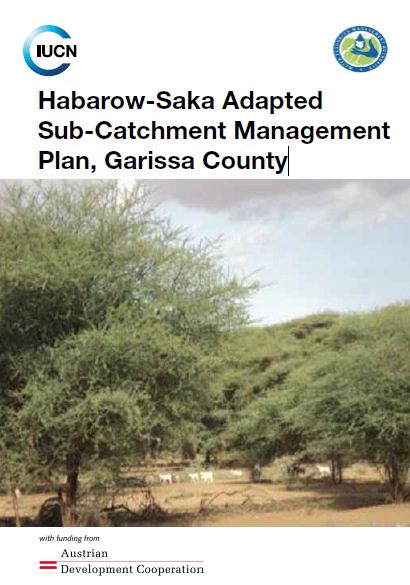Habarow-Saka Adapted Sub-Catchment Management Plan, Garissa County
The Adapted Sub-Catchment Management Plan for pastoral communities in the Arid and Semi-arid Lands (ASALs) of Kenya is a working document developed through a participatory process by engaging relevant stakeholders, including Water Resource Users Association (WRUA), other resource users associations, government officials and Non-Governmental Organizations (NGOs) to effectively manage and conserve natural resources through integrated resource management. ASCMPs consider both water and land resource management components to enhance equitable and sustainable resource management for improved livelihoods of communities in sub-catchments

Photo: IUCN ESARO
The ASCMP preparation followed the WRUA Development Cycle (WDC) guide with some additions to address the particular issues associated with arid areas. ASALs face different challenges compared to more humid environments and as such require different kinds of attention. The uncharacteristic nature of ASALs is manifested in the following amongst other things:
- Unique, heterogeneous and fragile ecosystems that are prone to degradation
- Most of the land is communally owned and migration is the back bone for survival
- Poverty levels are high and communities rely heavily on natural resources for their livelihood
- There are increasing constraints to mobility as dry season fodder/forage reserves are converted to arable agriculture.
- Mobility is further constrained by haphazard and mushrooming settlements in pasture areas
- The spread of invasive weeds such as Prosopis juliflora are adversely affecting natural pastures
- Adverse impacts of climate change in recent decades that contribute to higher rainfall variability and low reliability than in the past
- Weak governance due to dysfunctional traditional /customary laws and institutions and poorly or non-functioning modern laws and institutions, leading to the proliferation of unsustainable management practices
- Poor understanding of dryland systems leading to inappropriate approaches to development.
The Habarow – Saka Sub-catchment referred to in this report as Saka Sub-catchment for which this adapted SCMP was developed, is an arid land comprising over 90% range, mainly pastoral land. Consequently, the need to integrate rangeland planning and management component into this SCMP is of paramount importance in order to ensure holistic management of resources.
